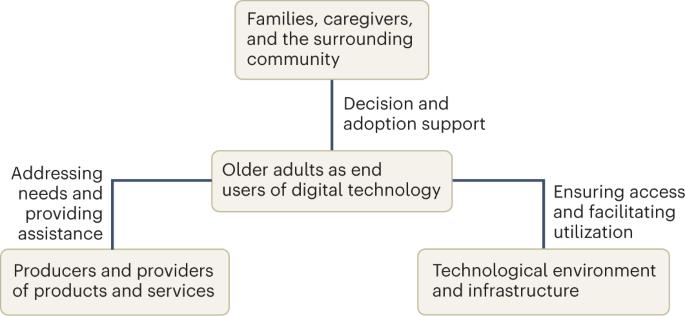Technology and aging: the jigsaw puzzle of design, development and distribution
Developments and advancements in enabling technologies must be paired with the appropriate design of products and services that address older adults’ needs and wants, support for improving awareness and availability, efforts to create effective messaging regarding potential benefits, and the development of education and technical support programs.
A more complete and holistic understanding of the decision-making processes of older adults may help to facilitate awareness and the adoption of new digital technologies and their applications. Characterizing older adults using stereotypes and assumptions has led to gaps in truly understanding users, and prevented designers, developers and marketers from fully considering the breadth and dynamic nature of various factors that drive adoption and use. Design efforts and research focus have been centered around the needs of physical health, safety and simplicity, and older adults have often been categorized as a single user group without a full description of the social settings and environments in which technology products and services may be used. Although target end-users may be older adults, designers and producers of technology can also consider reaching family caregivers and community members, as these individuals often act as intermediaries who obtain necessary information, support technology adoption decisions, and assist in decisions related to home and housing (Fig. 1). Understanding such social dynamics may also help to uncover untapped distribution and delivery channels. Furthermore, better outcomes will follow from increased efforts to include older adults and related decision-makers in the design process for an improved understanding of needs, idea generation, concept validation and design evaluation. These efforts can take many forms, including facilitating the direct inclusion of older adults in describing needs and goals, creating solution ideas, developing and prototyping product concepts, conducting pilot user experiments, and more16.

The successful use of technology-enabled products and services by older adults may be supported in various ways by multiple entities, including families, caregivers and social communities; technology providers; and the surrounding infrastructure.
In the area of public policy, governments, businesses and non-profit organizations should support universal access to platform technologies and systems such as broadband and smartphones or tablets, as these serve as enablers and channels for services and applications (Fig. 1). Equity and inclusion should be a goal for the development and distribution of new technologies to ensure that benefits are delivered to older adults and families in different areas and situations. The digital divides that exist between generations, socioeconomic groups and geographical communities may persist and even expand without commitments to improving technological infrastructure and facilitating the inclusion of older adults and other groups who are less likely to be digitally connected17. Equitable and universal access to adequate technology platforms and reliable connectivity is not only an enabler to facilitate technology use, but should also be a key consideration for infrastructure development as it could serve as a public health requirement.
Education is an important element for producers of technology and providers of related services, as well as for consumers and end users. Although few studies provide recommendations to incorporate technologies and accommodate related services (for example, ref. 18), many commercial guidelines and practical principles for aging in place focus on architectural design and elements of the physical environment (for example, doors, floors and handles) to ensure safety. Similarly, design guidelines for creating age-friendly user interfaces have traditionally been centered around improving readability and efficiency in graphical and menu-based interfaces, many of which may not be readily applicable to technologies that are embedded into the home. As new technologies continue to enter our aging society, design principles and requirements need to evolve and expand to be compatible with different possibilities such as naturalistic interfaces (for example, using speech or motion), increased automation, and integration with everyday products and services. Caregivers — both formal and informal — are also not equipped with the necessary knowledge to recommend and use technology products and services that may be helpful for their job, as well as for the well-being of the recipient of their care. Possibilities for technology use and integration, as well as the implications of potential benefits and risks, need to be considered in more detail.
Lastly, the standardization of key terminology and definitions (Box 1) may help to facilitate communications among designers, across stakeholders, and between producers and users. For example, although the concept of the ‘smart home’ has received popular attention and promises benefits to improve safety and convenience in the home, many older adults as well as much of the public cannot easily define what constitutes a smart home, and inconsistencies are found even among practitioners and researchers in related fields19. Effective communication to improve understanding of new technologies and their capabilities among older adults as well as other population groups will help to reduce knowledge gaps between users of different demographic, socioeconomic and experiential characteristics, and will help future consumers to easily incorporate technologies into their everyday lives.
A technology-enabled future has the potential to improve convenience, connectivity and care for older adults and families in a rapidly aging world. But for new technologies to truly aid older adults in remaining in their homes for longer, a holistic approach to address current and anticipated challenges — with support from public and private sectors, efforts from multiple industries and disciplines, and considerations that span technical and social dimensions — will be necessary.








Gloss